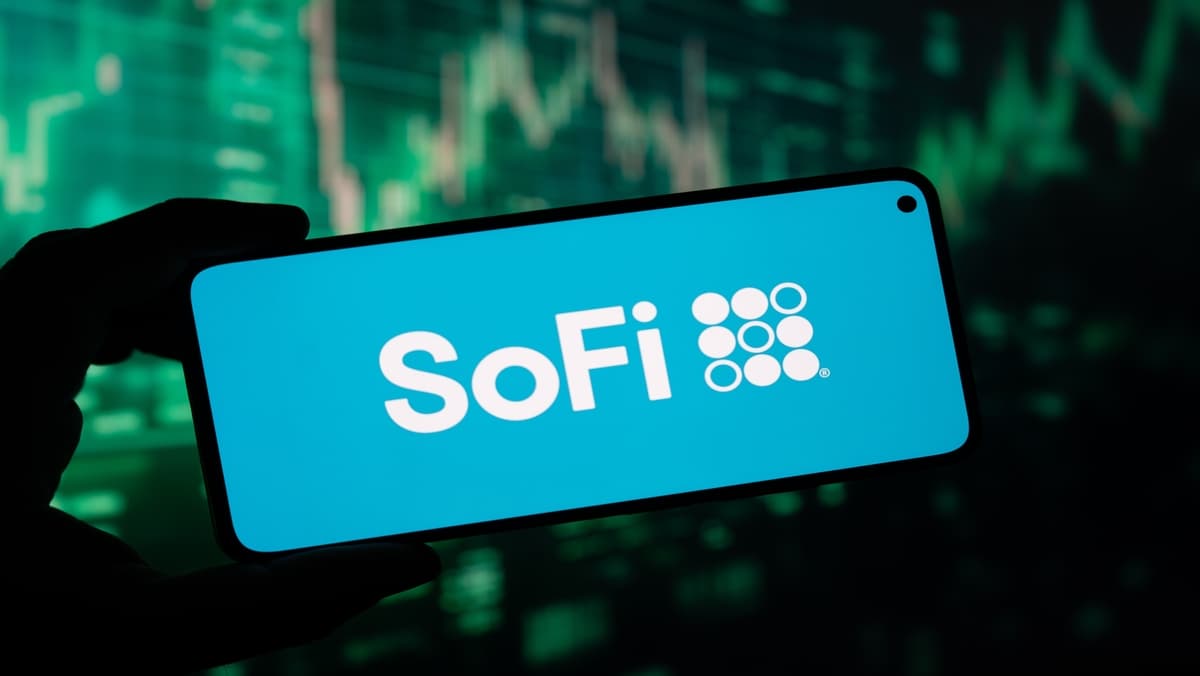CFD’er er komplekse instrumenter, og der er en stor risiko forbundet med disse for at miste penge på grund af gearing. 77.3 % af detailinvestorerne har tab på deres konto, når de handler CFD’er med denne udbyder. Du skal overveje, om du forstår, hvordan CFD’er fungerer, og om du har råd til at løbe en stor risiko for at miste dine penge.
Torsdag Jun 5 2025 06:24

6 min

SOFI Stock Analysis: SoFi Technologies is a fintech company offering a range of financial services, including lending, banking, and investment products.
Sofi stock price prediction 2025: founded in 2011, SoFi has transitioned from a student loan refinancing company to a full-spectrum digital financial services provider. This analysis will provide a comprehensive 5-year forecast for SoFi stock, examining its business model, financial health, market opportunities, risks, and valuation outlook.
SoFi operates primarily as a digital financial services platform targeting predominantly Millennials and Gen Z users who prefer online and mobile banking solutions. Its service lines include:
Lending: Student loan refinancing, personal loans, home loans.
Wealth Management: Automated investing, stock trading, cryptocurrency.
Banking: Cash management accounts, high-yield savings, and debit cards.
Insurance: Life insurance and other financial protection products.
The company’s subscription-based revenue model, combining interest income from loans and fees from its fintech platform, aims to create a sticky, recurring revenue base.
Revenue Growth
SoFi has demonstrated significant revenue growth in recent years. For example, its revenue grew from approximately $200 million in 2019 to over $1 billion in 2023, driven by rapid user growth and product diversification.
User Base Expansion
Its total member base has expanded to over 4 million members, with active engagement increasing as SoFi deepens its product offerings and cross-selling capabilities.
Profitability
While SoFi has yet to consistently generate net profits, its path toward profitability is clearer with improving operating margins and scale benefits. Its Q1 2025 results showed reduced losses and positive adjusted EBITDA, signaling operational leverage.
Balance Sheet and Capital
SoFi maintains a strong balance sheet with ample cash reserves and access to capital markets. Its recent efforts to securitize loan portfolios and reduce debt costs have improved financial flexibility.
Fintech Adoption Trends
The fintech sector’s growth remains robust, driven by digital adoption, demand for convenience, and cost efficiency. Millennials and Gen Z prioritize mobile-first banking, making SoFi’s platform well-positioned.
Addressable Market
SoFi’s addressable market includes:
Student loan refinancing market: Hundreds of billions in outstanding loans.
Personal loans: A growing market as consumers seek alternatives to traditional banks.
Investment and wealth management: Increasing interest in low-cost, accessible investing.
Banking and insurance: Large markets with potential for cross-sell.
Competitive Advantages
Brand recognition: Strong brand appeal among younger demographics.
Integrated platform: Seamless user experience across multiple financial products.
Technology: Scalable cloud-based infrastructure and AI-driven personalization.
Regulatory licenses: Banking charter and partnerships enabling product expansion.
Competitive Landscape
SoFi competes with traditional banks, neobanks, and fintech disruptors such as:
Traditional Banks: JPMorgan Chase, Bank of America.
Neobanks: Chime, Varo.
Fintech Lending Platforms: LendingClub, Upstart.
Investment Platforms: Robinhood, Wealthfront.
SoFi’s multi-product approach and banking charter give it advantages in customer acquisition and retention, though competition is intense and innovation rapid.
Regulatory Risks
As a financial institution, SoFi faces regulatory scrutiny across multiple fronts — lending practices, data privacy, and banking regulations. Changes could impact costs or limit product offerings.
Credit Risk
Loan portfolios expose SoFi to credit risk, particularly if economic conditions deteriorate and defaults increase.
Market Volatility
Investment and wealth management products are sensitive to market downturns, potentially affecting fee revenue.
Competition
The fintech space is crowded, with both startups and incumbents vying aggressively for market share.
Profitability Timeline
While improving, profitability is not yet guaranteed, and continued investment in growth could pressure margins.
Product Innovation
Continuous innovation in lending algorithms, AI-driven financial advice, and new insurance products can fuel growth.
Geographic Expansion
SoFi has begun expanding beyond the U.S. market, targeting Canada and the UK in the near term.
Partnerships and Acquisitions
Strategic acquisitions (e.g., Galileo, a payments platform) and partnerships enhance scale and capabilities.
Cross-Selling and Customer Lifetime Value
Increasing the average revenue per user by cross-selling multiple products is central to SoFi’s long-term value creation.
SoFi’s Valuation and Stock Outlook
Current Valuation Metrics
As of mid-2025, SoFi trades at a forward price-to-sales (P/S) ratio in the range of 5-7x, reflecting high growth expectations but also market caution given profitability concerns.
Analyst Price Targets
Wall Street analysts typically forecast upside potential of 20-40% over the next 12-24 months based on revenue growth and margin expansion projections.
5-Year Stock Price Forecast
Assuming SoFi continues to:
Grow revenue at 20-30% CAGR.
Achieve adjusted profitability within 2-3 years.
Expand user base to 10+ million active members.
Maintain competitive positioning and regulatory compliance.
The stock could reach a valuation range of $30-$50 per share in five years, representing a significant appreciation from current levels.
SoFi stands at an exciting inflection point as it matures from a high-growth startup into a sustainable fintech powerhouse. Its diversified fintech ecosystem, strong brand, and expanding product suite position it well to capitalize on ongoing digital transformation in financial services. While risks remain—particularly regulatory uncertainty and credit exposure—the company’s improving financial profile and strategic initiatives support a constructive 5-year outlook.
Investors with a medium to long-term horizon, comfortable with fintech volatility and growth investing, may find SoFi an attractive opportunity. However, close monitoring of profitability milestones, regulatory developments, and competitive dynamics will be key to managing risk.
When considering shares, indices, forex (foreign exchange) and commodities for trading and price predictions, remember that trading CFDs involves a significant degree of risk and could result in capital loss.
Past performance is not indicative of any future results. This information is provided for informative purposes only and should not be construed to be investment advice.